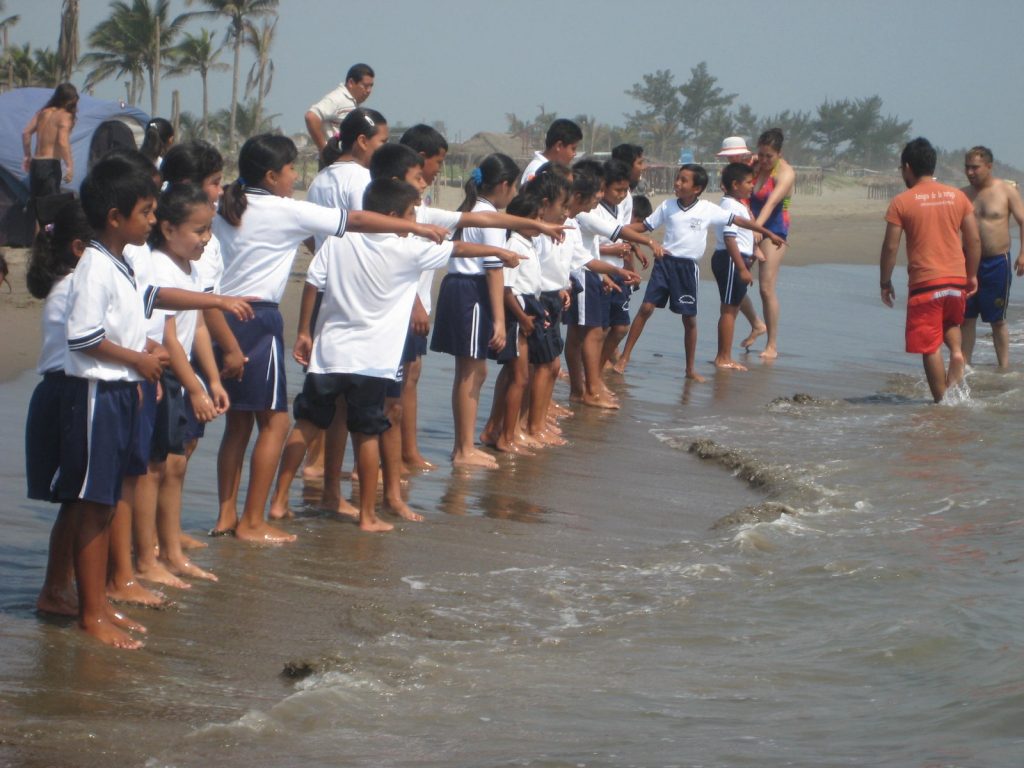
An End of Year Message from Mama and Papa Tortuga and all of the Vida Milenaria Team!
Merry Christmas to all the people who support us and keep us saving the sea turtles and Tecolutla! We are about to close the 2019 season and are filled with gratitude and hope and send you great big hugs.
Visit Us

Volunteer
Patrolling 20km of Tecolutla beach and
protecting nests are labor intensive. Come
help out!

Visit
Nesting, turtle releases, and education
sessions. From March through September,
there's always activity at Vida Milenaria!

Donate
ATV maintenance, nest preservation
supplies, and education materials. Your
donation helps preserve turtles!
Kemp's ridley
2019 Nesting
Kemp's Ridley Facts
“Kemp’s ridley” is the American name for the species of sea turtle being protected by Fernando Manzano in Tecolutla, Veracruz, Mexico. The name “Kemp” comes from Richard Kemp, a Florida fisherman who discovered this species in 1880 and sent the specimen to Harvard University to be studied. In Mexico they call these turtles “Tortuga Lora”. Lepidochelys kempii is the scientific name. Listed as endangered under the U.S. Federal Endangered Species Act, and as Critically Endangered by the International Union for Conservation of Nature and Natural Resources, Kemp’s ridley is the most endangered species of all sea turtles.


Kemp's Ridley Description
There are seven different species of sea turtles and Kemp’s ridley is the smallest. The average adult weight is between 75 and 100 pounds, and their shells measure between 24 and 28 inches in length. Kemp’s ridley shells (carapace) are grayish green and their skin color varies from green to yellow to white. Their undersides (plastron) are usually cream-colored or greenish yellow. Hatchlings are entirely black. The front flippers have one claw each, while rear flippers have either one or two claws.
Kemp's Ridley Nesting
The Kemp’s ridley is the only sea turtle that nests and lays its eggs during the daytime. High winds usually precede the return of female turtles to the same beaches where they were born. Once on shore, a female will crawl around as though she is looking for the “perfect spot” and then she will dig a nest into which she deposits 100 or so ping-pong ball size eggs. She covers them up with sand and heads back to the sea. Nesting usually occurs in arribadas, or groups of many turtles coming ashore on one stretch of beach together. Females will come ashore to nest two or three times per season. The season begins around the middle of April and lasts until July. Eggs incubate for approximately 50 – 60 days before the hatchlings work to let themselves out of their eggs. They cut open their leathery eggshells with a sharp point called a caruncle, which they have (only temporarily) on their snout. They then work as a group to dig themselves out of the sandy nest.


Kemp's Ridley Population
There are many other organizations that are dedicated to preserving Kemp’s ridley sea turtles as well as other endangered sea turtles. Please support them!
Vida Milenaria and Education
- over 10,000 people attend the camp
- Over 220 days Environmental Education Workshops are conducted

Student from over 60 schools, and adults who participate mainly come from Mexico City, Mexico State, Tlaxcala, Chihuahua, Puebla, Nuevo Leon, as well as several municipalities in the states of Xalapa, Orizaba, Veracruz, and Poza Rica. Also there are many students of primary schools in the communities of Tecolutla who participate.
Flickr photos from the album KIds at Vida Milenaria by saveloraturtles.


Papa Tortuga

Yes, one person CAN make a difference.
There’s proof in a small fishing village in Mexico. It was there, at the age of 16, that Fernando Manzano found his purpose. Now, several decades later, he continues to dedicate his life to bringing Kemp’s ridley sea turtles back from the edge of extinction. His efforts have made a remarkable impact on the population of this critically endangered species. His passion touches thousands of people each year, and Fernando has become a role model in his community where he has turned poachers into protectors.
In his youth, Fernando was disturbed by the common practice of eating sea turtle meat and eggs. It anguished him when his father insisted that he drink sangria made with turtle blood, claiming that it would strengthen his lungs.
From the 1940s – 1970’s humans were responsible for a drastic decline in the population of Kemp’s ridleys – to the point of near extinction. Most people did not seem to notice or care about this, but Fernando Manzano was different.
Inspired by a Jacques Cousteau documentary, this young man took it upon himself to help the turtles. Originally, Manzano worked solo, but it was soon evident to him that community education and involvement was crucial to his mission. He formed the nonprofit, Vida Milenaria AC, an organization dedicated to long term protection of sea turtles. Now many Tecolutla residents, as well as volunteers from all over the world, help with beach patrol, nest protection and other conservation tasks.
Thanks to Fernando’s determination, there has been a significant increase in the population of Kemp’s ridleys on the beaches of Tecolutla. In 1974 Fernando found just five nests to protect. Now he and his team at Vida Milenaria protect many hundreds of nests each year.
Education is one of Fernando’s most important jobs. Thousands of children visit annually, to participate in the release of hatchlings. The smiles on their faces and exclamations of awe are some of Fernando’s favorite rewards. This enriching experience not only opens their hearts to the plight of an endangered species, it also teaches them the importance of caring for our planet.
Señor Manzano’s cousin scolded him recently about his financial situation, showing concern for the fact that Fernando does not have “enough capital”. Fernando smiled at his cousin and replied, “I have millions in capital. They’re out there, swimming in the sea”.
Our Impact
Papa Tortuga was created by the Arizona-based production company, Aspen ProMedia (Ukrainian translation is provided by Gde Traffic). This is their first documentary. This film is a half hour tribute to a very special man and his mission. It is full of beautiful underwater photography and emotional interviews. Plus, another element of this video, which adds so much to its artistic expression, is the music. Composer, singer & guitar player, Lazaro Herrera, with his Latin band Synthesis provided the beautiful sounds. The Papa Tortuga documentary has been shown at numerous film festivals, and has also been shown on the PBS program Natural Heroes.
Tecolutla
Tecolutla is a small fishing town in the state of Veracruz, on the Gulf of Mexico, and the hometown of Papa Tortuga. A midpoint between Tampico and the bustling port city of Veracruz, it takes five or six hours to drive from Mexico City through the mountains to Tecolutla.
This is not a town frequented by American tourists, but it is a favorite vacation spot for “middle class” Mexicans who come to spend their holidays at the sea. It is a colorful town with plenty of charming, little fresh air restaurants and souvenir shops. Musicians stroll the beaches, the streets and just seem to turn up everywhere, with marimbas, harps, drums, etc. It is a village that is almost surrounded by water, with the rich Rio Tecolutla bordering the south west side.
El Tajin, an archeological site dating back to around 300A.D. is only about a half hour drive away from Tecolutla. It is fascinating to explore this ancient city, with its pyramids and sacred ball courts. The Voladores of Papantla perform here daily, displaying their amazing act of worship which has them climbing to the top of a 150 foot pole, tying rope around their ankles and jumping off. While they spin gracefully down and around the pole in their colorful costumes, another member remains balanced at the top, playing traditional melodies of the Totonaca Indians.

Mission
The mission of the Tecolutla Turtle Preservation Project is to support the protection and conservation of marine turtles, particularly Kemp’s ridley sea turtles in Tecolutla, Veracruz, Mexico.
We provide financial support to Vida Milenaria, a grassroots preservation effort in Tecolutla, Mexico that has helped protect hundreds of thousands of Kemp’s ridley sea turtle nests in the past 35 years. The founder of this effort, Fernando Manzano, is featured in the documentary Papa Tortuga , which has aired on Public Television as part of the Natural Heroes series. The documentary has also been featured in a number of film festivals throughout the United States.
Tecolutla Turtle Preservation
Project Board
The Tecolutla Turtle Preservation Project (TTPP) board is comprised of community members with a passionate interest in the efforts of Fernando Manzano (Papa Tortuga) to protect nesting of Kemp’s ridley sea turtles along Gulf of Mexico, specifically the beaches of Tecolutla, Mexico. Each of us is committed to the success of his efforts.
Chairperson
Chairperson Emeritus
Board Member Emeritus
Treasurer
Board Member
Board Member
Board Member
Board Member
Board Member
Board Member
Research Connections
The Tecolutla Turtle Preservation Project (TTPP) in 2013 was approached by several members of the Kemp’s ridley research community to engage in the study of Kemp’s ridleys along the Tecolutla coast. We’re very excited to have these connections with the research community, and look forward to supporting their studies.
Dr. Mark Roberts
Dr. Mark Roberts is investigating the population dynamics of Kemp’s ridley nesting beaches through genetic analyses of nesting females as well as the establishment of a long term, rigorously monitored “index nesting beach” project at Tecolutla, Mexico. These research and monitoring efforts will address high priority areas in sea turtle conservation and more specifically in the NMFS’ Kemp’s ridley recovery plan.
Dr. Andrew Coleman
Dr. Coleman is a scientific advisor to TTPP and began a research collaboration at Tecolutla with TTPP, Vida Milenaria, and Dr. Roberts in 2013. He is interested in examining aspects of Kemp’s ridley ecology and reproductive physiology. You can follow his research on Twitter @GulfSeaTurtles
TTPP News

An End of Year Message from Mama and Papa Tortuga and all of the Vida Milenaria Team!
Merry Christmas to all the people who support us and keep us saving the sea turtles and Tecolutla! We are about to close the 2019 season and are filled with gratitude and hope and send you great big hugs.

An End of Year Message from Mama and Papa Tortuga and all of the Vida Milenaria Team!
Merry Christmas to all the people who support us and keep us saving the sea turtles and Tecolutla! We are about to close the 2019 season and are filled with gratitude and hope and send you great big hugs.

International Sea Turtle Symposium, 2019
TTPP was thrilled to help support travel to the meeting by our favorite “turtlers,” Papa and Mama Tortuga (Fernando Manzano and Irma Galvan Tejada) of Vida Milenaria, thanks to our generous donors! Fernando and Irma were grateful for the opportunity to learn, share, and connect with other sea turtle conservationists from around the globe.

Celebrate Earth Day
Our board president, Laura Kiehner, put this video together as a thank you to Vida Milenaria AC, for their dedication to sea turtles. They have inspired us, and so many others to take better care of our planet!

Satellite Tagging of Nesting Turtle
SO MUCH EXCITEMENT at VIDA MILENARIA! More than 80 TURTLES CAME TO NEST TODAY! The VM crew has their hands full, working so hard to protect the precious eggs of an endangered species! PLUS, here are recent photos showing personnel from the Aquarium of Veracruz outfitting a Kemp’s ridley with a satellite transmitter (in collaboration with the Gladys Porter Zoo).
Locations
TECOLUTLA TURTLE PRESERVATION PROJECT
1411 W 10th St, % Rick Wilson
Cleveland OH, 44113
USA

Phone
CALL US
(484) 474-0055
